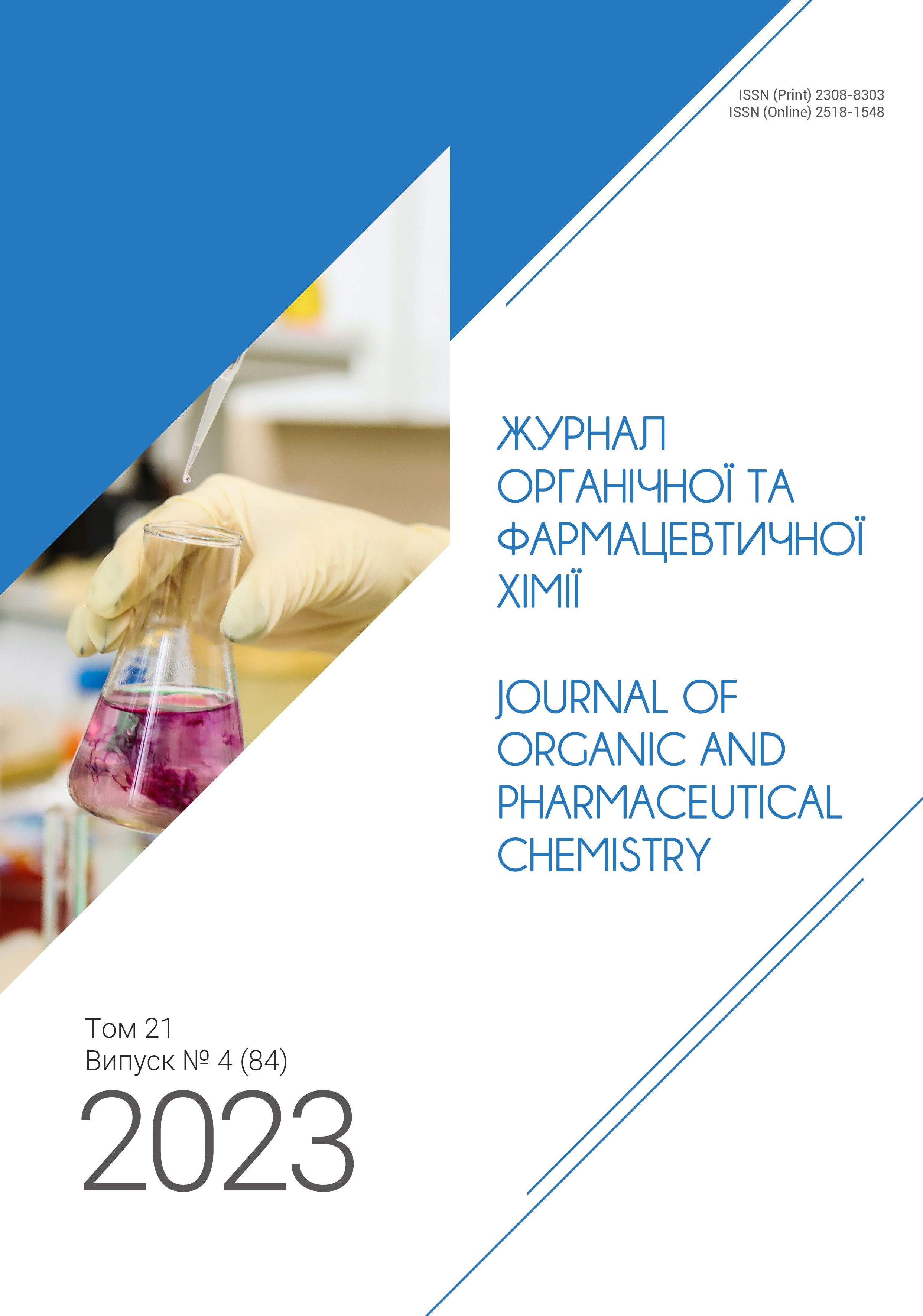A Simple Preparative Synthesis of Isomeric 2-Chloroquinolinecarboxylic Esters
DOI:
https://doi.org/10.24959/ophcj.23.298574Keywords:
2-chloroquinoline, esters, oxidation, quinolone-2, chlorinationAbstract
A simple two-stage method for the synthesis of isomeric esters of 2-chloroquinoline-5-, 6-, 7-carboxylic acids by successive oxidation and chlorination reactions of methyl quinoline-5-, 6-, 7-carboxylates has been developed. The target compounds have been obtained in acceptable yields using readily available reagents, simple transformations, and purification methods. Quinoline-8-carboxylic acid ester is unreactive under these conditions. The ester of 2-chloroquinoline-8-carboxylic acid has been obtained with an overall yield of 55%, starting from 8-methylquinoline. The multi-stage process is paid off by the fact that several transformations occur in one reaction cycle. All the methods developed can be used for the synthesis of target compounds on a multigram scale. Intermediate 2(1H)-oxoquinoline carboxylates are promising compounds in the synthesis of functionalized and condensed heterocycles.
Supporting Agency
- The authors received no specific funding for this work.
Downloads
References
- Hamama, W. S.; Ibrahim, M. E.; Gooda, A. A.; Zoorob, H. H. Recent advances in the chemistry of 2-chloroquinoline-3-carbaldehyde and related analogs. RSC Adv. 2018, 8 (16), 8484 - 8515. https://doi.org/10.1039/C7RA11537G.
 |
| 
- Lee, B. S.; Lee, J. H.; Chi, D. Y. Novel Synthesis of 2-Chloroquinolines from 2-Vinylanilines in Nitrile Solvent. J. Org. Chem. 2002, 67 (22), 7884 - 7886. https://doi.org/10.1021/jo016196i.
 |
| 
- El-Sayed, O. A.; Al-Bassam, B. A.; Hussein, M. E. Synthesis of Some Novel Quinoline-3-carboxylic Acids and Pyrimidoquinoline Derivatives as Potential Antimicrobial Agents. Arch. Pharm. 2002, 335 (9), 403 - 410. https://doi.org/10.1002/1521-4184(200212)335:9<403::AID-ARDP403>3.0.CO;2-9.
 |
| 
- Kaur, K.; Jain, M.; Reddy, R. P.; Jain, R. Quinolines and structurally related heterocycles as antimalarials. J. Med. Chem. 2010, 45 (8), 3245 - 3264. https://doi.org/10.1016/j.ejmech.2010.04.011.
 |
| 
- Abdou, W. M.; Khidre, R. E.; Shaddy, A. A. Synthesis of Tetrazoloquinoline-Based Mono- and Bisphosphonate Esters as Potent Anti-Inflammatory Agents. J. Heterocycl. Chem. 2013, 50 (1), 33 - 41. https://doi.org/10.1002/jhet.968.

- Abdou, W. M.; Khidre, R. E.; Kamel, A. A. Elaborating on Efficient Anti-Proliferation Agents of Cancer Cells and Anti-Inflammatory-Based N-Bisphosphonic Acids. Arch. Pharm. 2012, 345 (2), 123 - 136. https://doi.org/10.1002/ardp.201100080.
 |
| 
- Selvi, S. T.; Nadaraj, V.; Mohan, S.; Sasi, R.; Hema, M. Solvent free microwave synthesis and evaluation of antimicrobial activity of pyrimido[4,5-b]- and pyrazolo[3,4-b]quinolines. Bioorg. Med. Chem. 2006, 14 (11), 3896 - 3903. https://doi.org/10.1016/j.bmc.2006.01.048.
 |
| 
- Dine, I.; Mulugeta, E.; Melaku, Y.; Belete, M. Recent advances in the synthesis of pharmaceutically active 4-quinolone and its analogues: a review. RSC Adv. 2023, 13 (13), 8657 - 8682. https://doi.org/10.1039/D3RA00749A.
 |
| 
- Kumar, G.; Saroha, B.; Kumar, R.; Kumari, M.; Kumar, S. Recent Advances in Synthesis and Biological Assessment of Quinoline-Oxygen Heterocycle Hybrids. ChemistrySelect 2021, 6 (20), 5148 - 5165. https://doi.org/10.1002/slct.202100906.

- Shvekhgeimer, M. G. A., The Pfitzinger Reaction. (Review). Chem. Heterocycl. Comp. 2004, 40 (3), 257 - 294. https://doi.org/10.1023/B:COHC.0000028623.41308.e5.

- Mandal, S.; Bhuyan, S.; Jana, S.; Hossain, J.; Chhetri, K.; Roy, B. G. Efficient visible light mediated synthesis of quinolin-2(1H)-ones from quinoline N-oxides. Green Chem. 2021, 23 (14), 5049 - https://doi.org/10.1039/D1GC01460A.

- Pachupate, N. J.; Vaidya, P. D. Catalytic wet oxidation of quinoline over Ru/C catalyst. Journal of Environmental Chemical Engineering 2018, 6 (1), 883 - https://doi.org/10.1016/j.jece.2017.12.014.

- Abe, H.; Sato, A.; Tokishita, Sh.-i.; Ohta, T.; Ito, H. Synthesis of Fluorescence Pyriproxyfen Analogues as Juvenile Hormone Agonists. Heterocycles 2011, 83 (7), 1649 - 1658. https://doi.org/10.3987/COM-11-12232.

- Qiao, K.; Wan, L.; Sun, X.; Zhang, K.; Zhu, N.; Li, X.; Guo, K. Regioselective Chlorination of Quinoline N-Oxides and Isoquinoline N-Oxides Using PPh3/Cl3CCN. J. Org. Chem. 2016, 2016 (8), 1606 - 1611. https://doi.org/10.1002/ejoc.201501567.

- Friedlaender, P.; Ostermaier, H. Ueber das Carbostyril. II. Chem. Ber. 1882, 15 (1), 332-338. https://doi.org/10.1002/cber.18820150179.

- Chakrabartty, S. K.; Kretschmer, H. O. Sodium hypochlorite as a selective oxidant for organic compounds. J. Chem. Soc., Perkin Trans. 1 1974, 0, 222 - 228. https://doi.org/10.1039/P19740000222.

- Decker, H. Ueber die Einwirkung von Alkalien auf Jodalkylate der Chinolin- und Acridinreihe. Journal für Praktische Chemie 1892, 45 (1), 161 - 200. https://doi.org/10.1002/prac.18920450120.
- Fischer, O. Einwirkung von Phosphorpentachlorid auf N- Alkyl-Pyridone und-Chinolone. Chem. Ber. 1898, 31 (1), 609 - 612. https://doi.org/10.1002/cber.189803101127.

- Yang, J.; Gustavsson, A.-L.; Haraldsson, M.; Karlsson, G.; Norberg, T.; Baltzer, L. High-affinity recognition of the human C-reactive protein independent of phosphocholine. Org. Biomol. Chem. 2017, 15 (21), 4644 - 4654. https://doi.org/10.1039/C7OB00684E.
 |
| 
- Xu, W.; Nagata, Y.; Kumagai, N. TEtraQuinolines: A Missing Link in the Family of Porphyrinoid Macrocycles. J. Am. Chem. Soc. 2023, 145 (4), 2609 - 2618. https://doi.org/10.1021/jacs.2c12582.
 |
| 
Downloads
Published
How to Cite
Issue
Section
License
Copyright (c) 2024 National University of Pharmacy

This work is licensed under a Creative Commons Attribution 4.0 International License.
Authors publishing their works in the Journal of Organic and Pharmaceutical Chemistry agree with the following terms:
1. Authors retain copyright and grant the journal the right of the first publication of the work under Creative Commons Attribution License allowing everyone to distribute and re-use the published material if proper citation of the original publication is given.
2. Authors are able to enter into separate, additional contractual arrangements for the non-exclusive distribution of the journal’s published version of the work (e.g., post it to an institutional repository or publish it in a book) providing proper citation of the original publication.
3. Authors are permitted and encouraged to post their work online (e.g. in institutional repositories or on authors’ personal websites) prior to and during the submission process, as it can lead to productive exchanges, as well as earlier and greater citation of published work (see The Effect of Open Access).















